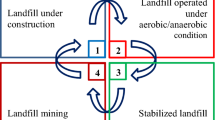Abstract
Three different laboratory bioreactors, each duplicated, with dimensions 0.5 × 0.5 × 1 m were set up and monitored for 160 days. Municipal Solid Wastes with an organic content of ~80 % and a density of 550 kg/m3 were placed in bioreactors. Fresh leachate collected from waste collection vehicles was used with a recirculation rate of 28 L/day. Aerobic bioreactors were aerated at a rate of 0.15–0.24 L/min/kg of waste. Almost the same level of treatment was observed in terms of chemical oxygen demand reduction of leachate, which was in the range of 91–93 %. However, for anaerobic bioreactor, it took almost twice the time, 160 vs. 76 days, to reach the same level of treatment and stabilization. The behavior of semi-aerobic bioreactor was somewhere between the aerobic and anaerobic ones. Total biogas production for anaerobic bioreactors was 90 L/kg of waste, which contained 57–63 % methane. Methane concentration measured in semi-aerobic bioreactor was below 5 %. The main advantage of aerobic bioreactor was the fast rate of the process, while for semi-aerobic bioreactor, it was the elimination of the need for energy to maintain aerobic conditions, and for anaerobic bioreactor it was the production of biogas and potential energy recovery.










Similar content being viewed by others
References
US EPA (2014) Municipal solid waste generation, recycling, and disposal in the United States: tables and figures for 2012, United States Environmental Protection Agency, Office of Office of Resource Conservation and Recovery. Feb 2014
Huang Q, Wang Q, Dong L, Xi B, Zhou B (2006) The current situation of solid waste management in China. J Mater Cycles Waste Manag 8:63–69
Bastian L, Yano J, Hirai Y, Sakai S (2013) Greenhouse gas emissions from biogenic waste treatment: options and uncertainty. J Mater Cycles Waste Manag 15:49–60
Zairi M, Aydi A, Dhia HB (2014) Leachate generation and biogas energy recovery in the Jebel Chakir municipal solid waste landfill, Tunisia. J Mater Cycles Waste Manag 16:141–150
Chong TL, Matsufuji Y, Hassan MN (2005) Implementation of the semi-aerobic landfill system (Fukuoka method) in developing countries: a Malaysia cost analysis. Waste Manag 25:702–711
Kheradmand S, Karimi-Jashni A, Sartaj M (2010) Treatment of municipal landfill leachate using a combined anaerobic digesterand activated sludge system. Waste Manag 30:1025–1031
Warith M (2002) Bioreactor landfills: experimental and field results. Waste Manag 22:7–17
Sponza DT, Agdag ON (2004) Impact of leachate recirculation and recirculation volume on stabilization of municipal solid wastes in simulated anaerobic bioreactors. Process Biochem 39:2157–2165
Ozkaya B, Demir A, Bilgili MS (2006) Mathematical simulation and long-term monitoring of leachate components from two different landfill cells. J Hazard Mater A135:32–39
Bilgili MS, Demir A, Ince M, Ozkaya B (2007) Metal concentrations of simulated aerobic and anaerobic pilot scale landfill reactors. J Hazard Mater 145:186–194
Townsend TG, Miller WL, Lee H, Earle JFK (1996) Acceleration of landfill stabilization using leachate recycle. ASCE J Environ Eng 122(4):263–268
Christensen TH, Kjeldsen P, Bjerg PL, Jensen DL, Christensen JB, Baun A, Albrechtsen HJ, Heron G (2001) Review: biogeochemistry of landfill leachate plumes. Appl Geochem 16:659–718
Erses SA, Fazal MA, Onaya TT, Craig WH (2005) Determination of solid waste sorption capacity for selected heavy metals in landfills. J Hazard Mater B121:223–232
He R, Liu X, Zhang Z, Shen D (2007) Characteristics of the bioreactor landfill system using an anaerobic–aerobic process for nitrogen removal. Bioresour Technol 98:2526–2532
San I, Onay TT (2001) Impact of various leachate recirculation regimes on municipal solid waste degradation. J Hazard Mater 87:259–271
Sanphoti N, Towprayoon S, Chaiprasert P, Nopharatana A (2006) The effects of leachate recirculation with supplemental water addition on methane production and waste decomposition in a simulated tropical landfill. J Environ Manag 81:27–35
Rich C, Gronow J, Voulvoulis N (2008) The potential for aeration of MSW landfills to accelerate completion. Waste Manag 28:1039–1048
Read AD, Hudgins M, Harper S, Phillips P, Morris J (2001) The successful demonstration of aerobic landfilling—the potential for a more sustainable solid waste management approach? Resour Conserv Recycl 32:115–146
Nikolaou A, Giannis A, Gidarakos E (2010) Comparative studies of aerobic and anaerobic treatment of MSW organic fraction in landfill bioreactors. Environ Technol 31:1381–1389
Fakharian K, Alami R, Abdi M (2003). Investigating the stability of Fukuoka method landfill at Kahrizak landfill, Tehran (in Persian). In: 6th International conference on civil engineering (ICCE2003), Isfahan, Iran, 2003
Cossu R, Raga R, Rossetti D (2003) The PAF model: an integrated approach for landfill sustainability. Waste Manag 23:37–44
Sun Y, Sun X, Zhao Y (2011) Comparison of semi-aerobic and anaerobic degradation of refuse with recirculation after leachate treatment by aged refuse bioreactor. Waste Manag 31:1202–1209
Erses SA, Onay TT, Yenigun O (2008) Comparison of aerobic and anaerobic degradation of municipal solid waste in bioreactor landfills. Bioresour Technol 99:5418–5426
Hirata O, Matsufuji Y, Tachifuji A, Yanase R (2012) Waste stabilization mechanism by a recirculatory semi-aerobic landfill with the aeration system. J Mater Cycles Waste Manag 14:47–51
APHA (2012) Standard methods for the examination of water and wastewater. APHA, AWWA, WEF
Author information
Authors and Affiliations
Corresponding author
Rights and permissions
About this article
Cite this article
Ahmadifar, M., Sartaj, M. & Abdallah, M. Investigating the performance of aerobic, semi-aerobic, and anaerobic bioreactor landfills for MSW management in developing countries. J Mater Cycles Waste Manag 18, 703–714 (2016). https://doi.org/10.1007/s10163-015-0372-0
Received:
Accepted:
Published:
Issue Date:
DOI: https://doi.org/10.1007/s10163-015-0372-0




